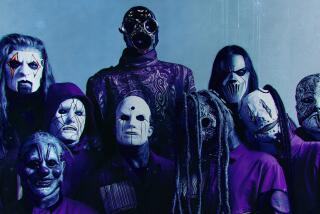Finding the future of live music in a Krakow salt mine and more Unsound revelations
Reporting fom KRAKOW, Poland — After decades of making music and watching it, I’ve developed a kind of town lunatic patter: “Why are we still watching bands on proscenium stages? We don’t use butter churns or ride in carriages!”
Music is now made on devices that didn’t exist 10 years ago; our venues can at least try to match that kind of innovation. As for the possibilities, Kraków’s Unsound festival is on it.
----------
For the Record
Jlin: An Oct. 24 music column about the Unsound festival in Krakow, Poland, mischaracterized the work that the artist known as Jlin (born Jerrilynn Patton) does at an Indiana steel plant. Jlin’s job involves banding enormous rolls of steel for storage, not reconditioning steel drums.
----------
One of the festival’s encoded principles, as articulated by organizers Malgorzata Plysa and Mat Schulz, is a foundational commitment to “taking unusual spaces and using them in new ways.” In Unsound’s case, that could be a church or a salt mine.
SIGN UP for the free Essential Arts & Culture newsletter >>
It all fit with the theme of this year’s recently concluded festival: surprise.
Festivals have themes for the same reason a suitcase has a handle with a pink ribbon tied around it. Someone needs to make a thing easily available while distinguishing it within a cohort: other festivals; other metallic cases on a carousel. Unsound’s theme of surprise could have just been a convenient tag. Many festival themes are. Performers show up, some having tied their work to the theme, while most just present whatever they happened to be working on. But an audience member can always say, “Oh, wait — we saw that at Surprise, in 2015.”
This year, however, Unsound delivered many solid variations on the theme of surprise — some engineered by Plysa and Schulz, but many born out of the festival’s unusual settings.
One night’s event, called Revelations, took place in the salt mines outside Kraków in Wieliczka. Most of us expected a cold, muddy cell with a few speakers tacked to the wall. Quite the opposite — the Wieliczka Salt Mines are one of Poland’s biggest tourist attractions, complete with restaurants, gift shops and a chamber big enough to accommodate bungee jumping. That night’s venue was probably the fanciest room we saw the entire week, a grand banquet hall hung with chandeliers and suffused with a blue light. The show felt like a slightly depressed wedding reception for a mastodon.
That night, surprise was stretched into prank. The second act to play was a figure standing at two CD decks, wearing a sweatshirt, face out of sight. Rumors spread that the performer was Burial, the reclusive British producer who has never appeared live, anywhere. Tweets started flying. People tried to Shazam the songs and get close enough to the stage so that they could figure out if it was, indeed, the man known legally as William Bevan.
Music is now made on devices that didn’t exist 10 years ago; our venues can at least try to match that kind of innovation.
— Sasha Frere-Jones
The tracks sounded like slightly beefed-up Burial songs but still Burial: reduced, cold, lost somewhere beyond the reach of the Sherpas. These songs had more melodic synth sounds than older Burial records, as well as the run-off crackle that make his records easily identifiable.
Unsound would neither confirm nor deny who played. The most plausible explanation by the end of the week was that Steve Goodman, a.k.a. kode9, had played a set of new Burial songs. Goodman was there, and I spoke to him. He simply laughed when presented with the idea that Bevan might have been at the salt mines. Anonymity is a great PR move, and cost-effective.
One simple and gorgeous use of surprise took place in Kraków’s main square (Rynek Glówny), where St. Mary’s Basilica is located. Every hour, on the hour, a trumpeter in the highest tower of the church plays a theme known as the “Hejnal Mariacki,” which translates as either “Saint Mary’s dawn” or “Saint Mary’s wake-up call,” depending how deep you go into the melody’s 13th century Hungarian roots.
Unsound mounted four “responses” to the “Hejnal.” None of these performances were made specific until afterward, meaning that the audience was largely tourists and natives strolling through the rainy square, looking up and wondering where the weird sounds were coming from.
The theme is traditionally played on trumpet four times in a row, once in each cardinal direction. On Sunday, electronic musician Tim Hecker set up a speaker in a tower of the old town hall facing the church. Every time the trumpeter played the Hejnal theme from St. Mary’s, Hecker responded with a slow pattern of bell tones that sounded like a sedated music box. It was as free as music gets. No names, no faces, no stage. It was just signals in the air, tied to no physical event. If you want an inverse of the stadium rock spectacle, this was it.
New York’s own Matana Roberts was a surprise simply by changing the nature of ritual within a synagogue. At the Synagoga Tempel in Kazimierz, Roberts seated herself with a saxophone, a notebook, many scarves and a set of loops. Behind her, a screen cycled images of what seemed to be 19th century photographs of African Americans, interwoven with shots of buildings and flashing red runes. Roberts’ loops sometimes roared with thick, pink noise, threatening to drown out her voice. She sang, spoke and ululated, punctuating her recitations with the words “I like to tell stories,” always delivered calmly. She played saxophone, avoiding identifiable themes that repeated and tending more toward flurries of notes that signaled something like a station stop or a change in direction. The effect was that Roberts had summoned up a new faith in an old house of worship, reaching back through American history and gently rewinding it around her.
Sometimes the surprise was just joy. Jlin, born as Jerrilynn Patton, works at a steel plant near her home in Gary, Ind. (Her current job is reconditioning steel drums.) A part of the Chicago footwork scene who claims R.P. Boo as her mentor, Jlin has released an album called “Dark Energy,” but she had played only one show in America (in August at MoMA PS1’s Warm-Up) before her Unsound appearance. Her Unsound set took place at the Hotel Forum, which has become the traditional hub for the festival’s weekend half. The main room is part of the lobby of a massive, demobbed hotel, the height of luxury in the ‘80s and a favorite of Communist apparatchiks. From the outside, it’s a brutalist dream of gray concrete and oblique angles. Inside, there’s plenty of faded carpet and warm brown wood, a bit like L.A.’s mid-century modern aesthetic adapted by someone designing a bank on Park Avenue in the ‘70s.
Jlin entered with her dreads already flying, the crowd already beginning to cheer. As she explained later, she sticks to the footwork rule of keeping tracks all in the range of 160 beats per minute. (That’s fast.) Her material moves in irregular ways, hiccuping and extending itself where another producer would choose to go ahead and kick in, making things easier for the dancers.
For a new song dedicated to her mentor, “Boozilla,” Jlin sampled the opening note of Akira Ifukube’s theme for “Godzilla vs. Mothra,” made famous by Pharoahe Monch’s 1999 hit, “Simon Says.” Adding Godzilla’s original howl, Jlin then made the sounds into jittery ostinatos. She never played the full theme, so anyone too young for either old Godzilla movies or ‘90s hip-hop would simply have heard a horn stab riding a rumble of kick drums and unidentified whooshes.
Her set was a continuous flux, or maybe a fluctuation repetition. Dance music often reinvents the dance by making dancing seem almost impossible: Think of early dubstep’s nothingness or jungle’s everythingness. Jlin’s footwork music moves like the one thing she mentioned when I asked her about her influences: water.
During her set, Jlin pumped her fist and danced along to most of her tracks, a deviation from the succession at Hotel Forum of People Standing Seriously At Their Laptops While Abstract Visuals Bubble Ominously In The Background. After the show, backstage, Jlin didn’t stop smiling while greeting fans and journalists. When someone asked her when she was going to quit her day job, she said, “Oh, that’s happening. I’m making that transition.”
Not a surprise.
Twitter: @sfj
ALSO:
How a Satanism accusation and Internet troll culture disrupted Krakow’s Unsound festival
The ice couple of pop: Lana del Rey and the Weeknd’s numb cool vs. the heat of Kanye and Rihanna
Why N.W.A belongs in the Rock and Roll Hall of Fame
More to Read
The biggest entertainment stories
Get our big stories about Hollywood, film, television, music, arts, culture and more right in your inbox as soon as they publish.
You may occasionally receive promotional content from the Los Angeles Times.










